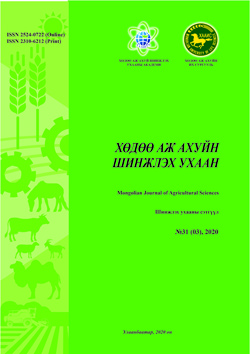Analyze using dummy variables in the soil (Examples of crop cultivation centers and irrigation)
DOI:
https://doi.org/10.5564/mjas.v31i3.1554Keywords:
coccidia, fecal sample, saturated solution of sugar, flotation methodAbstract
The rotation of the crop is important in selecting the right structure of the irrigation crop. If the cultivation system is applied scientifically enough, it is possible to observe high-yielding elements of intensive technology such as soil treatment, fertilization systems, seeds, quality of varieties, irrigation norms, combustion of pests and weeds and mechanization of production. The irrigation crop area is divided into different types (crops, fodder plants, vegetable and mixed crops) depending on the type of plant that is mainly cultivated in our country.
The “Gatsuurt” plant, located in the central cropping zone, has been subjected to a dependent analysis using the dummy variables of the cultivation of crops (wheat, potato, and so on) as a result of 2577 hectares of irrigation 141 areas. The company analyzed the soil and irradiated soil in the irrigated area in 2016. There are eight varieties of wheat, potatoes, rapeseed, oats, barley, perennials, carrots and onions. It shows that in the previous year, wheat was 0.78, potato was 0.79, rapeseed was 0.09, oatmeal was 1.46, barley was 0.44, perennial was 0.46 and 0.93 was phosphorus. It is possible to explain each equation.
Growth in irrigated farming in the central crop area - Wheat - Nitrogen and potatoes - Thickness, rapeseed - salt and oats - phosphorus, barley - CO2, perennial - potassium, onions and carrots - Mg increases soil.
Хөрсний үзүүлэлтэд зохиомол хувьсагч ашиглан шинжилгээ хийх арга
(Газар тариалангийн төв бүс, усалгаатай тариалалтын үед)
Усалгаатай тариалангийн таримал ургамлын бүтцийг зөв сонгон шийдвэрлэхэд таримлын сэлгээ чухал үүрэгтэй. Ээлжлэн тариалах системийг шинжлэх ухааны үндэслэлтэй, тооцоолол шинжилгээтэй нэвтрүүлсэн тохиолдолд хөрс боловсруулалт, бордох систем, үр, сортын чанар, усалгааны норм, горим, хортон шавьж, хог ургамалтай тэмцэх, үйлдвэрлэлийг механикжуулах зэрэг эрчимжсэн технологийн элементүүдийг мөрдөж өндөр ургац авах боломжийг бүрдүүлж чадна. Усалгаатай тариалангийн талбайн сэлгээ нь голлон тариалах ургамлын төрлөөс хамааруулж, хэд хэдэн төрлийг (үр тарианы, тэжээлийн ургамлын, хүнсний ногооны, холимог тариалан) сонгон авч шинжилгээ хийсэн.
Тооцооллын үр дүнгээс харахад газар тариалангийн төв бүсэд усалгаатай тариалалтын үед хөрсний азотыг нэмэгдүүлэхийн тулд өмнөгч нь буудай, арвай, олон наст, лууван, сонгино байвал илүү оновчтой гэсэн дүгнэлт гарч байгаа бол хэрэв өмнөгч нь лууван бол хөрсөн дэх ялзмаг, фосфор, кали хэмжээ нэмэгддэг байна. Хөрсөн дэх кали хэмжээг хамгийн ихээр нэмэгдүүлдэг өмнөгч тариалалт нь овьёос, олон наст байна. Өмнөгч нь рапсын тариалалт байхад хөрсний гол элементүүд болох азот, фосфор, кали –д сөрөг нөлөө үзүүлдэг болохыг харж болно.
Түлхүүр үг: Сэлгээ тариалалт, хамаарлын шинжилгээ, dummy (дамми) хувьсагч, өмнөгч тариалалт
Downloads
283
Downloads
Published
How to Cite
Issue
Section
License
Copyright on any research article in the Mongolian Journal of Agricultural Sciences is retained by the author(s).
The authors grant the Mongolian Journal of Agricultural Sciences a license to publish the article and identify itself as the original publisher.

Articles in the Mongolian Journal of Agricultural Sciences are Open Access articles published under a Creative Commons Attribution 4.0 International License CC BY.
This license permits use, distribution and reproduction in any medium, provided the original work is properly cited.




